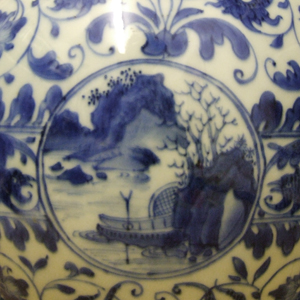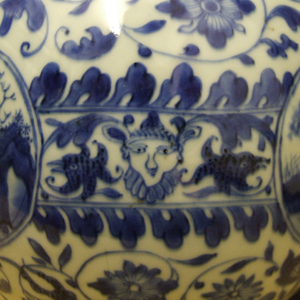
CHONGZHEN 1628 – 1644 Transitional Porcelain
A Fine Large Transitional Blue and White Porcelain Vase, Late Ming, Chongzhen Period c.1640. Decorated in Rich Tones of Cobalt Blue Using an Amalgam of Different Styles. The Neck Design of Elegant Symmetrically Arranged Stems of Carnation is Influenced by Islamic Patterns, Especially Turkish Iznik Fritware. The Scroll Decoration of the Body is also Probably Influenced by Turkish Ottoman Design, Although the Origin is Somewhat Difficult to Discern, not Least as Turkish Patterns were Heavily Influenced by Imported Chinese Blue and White Porcelain. The Roundels are Decorated in the Chinese Manner with River Landscapes. They are Linked by Panels in the Grotesque Style of Late Renaissance Mannerism, with a Human Head Flanked by Scroll-Work with Faces Hidden within the Foliage.
SOLD
- Condition
- Perfect.
- Size
- Height : 37 cm (14 1/2 inches)
- Provenance
- N/A
- Stock number
- 21911
- References
- For a Transitional blue and white porcelain ewer of this design dated to 1645- 1665 see : Eastern Ceramics and Other Works of Art From The Collection of Gerald Reitlinger, Catalogue of the Memorial Exhibition, Ashmolean Museum 18 July-13 September 1981 (Ashmolean Museum, Sotheby Parke Bernet. ISBN 0-85667-115-0) page 34, plate 50.
Information
The Transitional Period c.1620 - 1683 :
This is a term used in the West to describe Chinese porcelain made during the turbulent times that befell China in the 17th Century. From the disintegration of the Ming Dynasty and it`s eventual collapse in 1644 through the troubled start of a new `Foreign` Qing dynastic house. The roots of this unsettled period starts during the later part of Wanli`s reign (1573-1620). At the begging of his reign China was doing very well, new crops from the Americas such as peanuts, maize and sweet potatoes increased food production, while simplified taxes helped the state run smoothly. But this was not due to Wanli`s enlightened reign, but to his Mother championing a man that was to become the Ming dynasties most able minister, Zhang Zhuzheng (1525—1583). Wanli became resentful of Zhuzheng`s control but upon his death became withdrawn from court life. Between 1589 to 1615 he didn`t appear at imperial audiences, leaving a power vacuum that was filled by squabbling ministers. Mongols from the North raided as Japan invaded Korea. Wanli re-opened the silver mines and imposed new taxes but the money was lost due to corruption, as well as being frittered away by the indulgent Emperor himself . The next emperor of Ming China, Tianqi (1621-1627), was bought up in this self indulgent disorganised environment, at the very young age 15 his short reign started. He didn`t stand a chance. Tianqi made the mistake of entrusting eunuch Wei Zhongxian (1568-1627) who Anna Paludan in her excellent book "Chronicle of the Chinese Emperors" (Thames and Hudson, 1998) describes as "a gangster of the first order". Tianqi was deemed to have lost the Mandate of heaven by the Ming people. Tianqi`s younger brother, the last of the Ming Emperors, Chongzhen (1628-1644), was not able to save the situation. The systems of administration had broken down, corruption was rife and so when a sever famine broke out in 1628 nothing much could be done. Anna Paludan describes the tragic end to the great Ming Dynasty "The final drama was worthy of a Greek tragedy. The emperor called a last council in which `all were silent and many wept`, the imperial troops fled or surrendered, and the emperor, after helping his two sons escape in disguise, got drunk and rushed through the palace ordering the women to kill themselves. The empress and Tianqi`s widow committed suicide; the emperor hacked off the arm of one daughter before killing her sister and the concubines. At dawn he laid his dragon robe aside and dressed in purple and yellow, with one foot bare, climbed the hill behind the now silent palace and hanged himself on a locust tree". The Great Wall of China, started 2,000 years ago was built to protect China from the Northern barbarian hoards, it was often tested and sometimes failed. The Jin people invaded China, ruling the North between 1115 and 1234, it was their descendants the Manchus, Jurchens from south east Manchuria that took full advantage of the problems of the Ming dynasty. In 1636 they adopted a Chinese dynastic name, the `Great Qing` (Qing meaning pure). The first of the Qing emperors was Shunzhi (1644-1661) but for most of his reign his uncle ran the state. War raged on during this period and it wasn`t until the second Qing emperor Kangxi (1662-1722) that true peace was achieved. Kangxi was a wise and educated man, he became a highly successful emperor bringing China a long period of wealth and stability.







